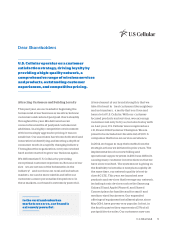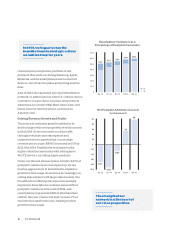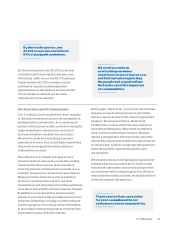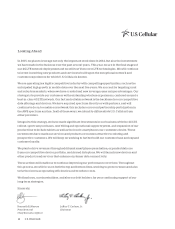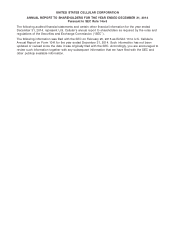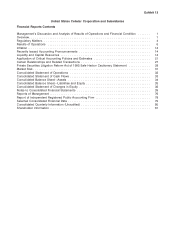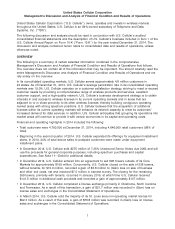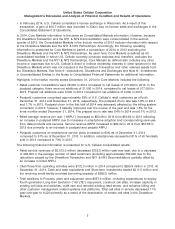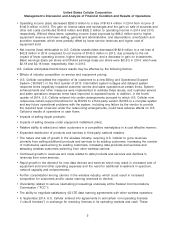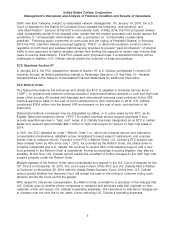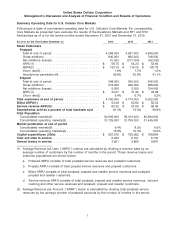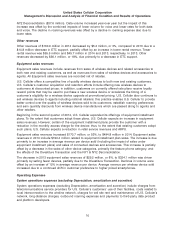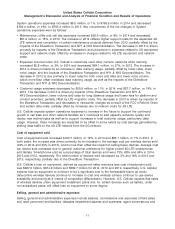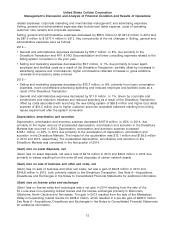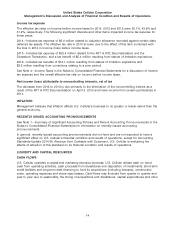US Cellular 2014 Annual Report Download - page 12
Download and view the complete annual report
Please find page 12 of the 2014 US Cellular annual report below. You can navigate through the pages in the report by either clicking on the pages listed below, or by using the keyword search tool below to find specific information within the annual report.United States Cellular Corporation
Management’s Discussion and Analysis of Financial Condition and Results of Operations
transactions are subject to regulatory approval and are expected to close in 2015. See Note 6—
Acquisitions, Divestitures and Exchanges in the Notes to the Consolidated Financial Statements for
additional information related to these transactions;
• In January 2015, U.S. Cellular entered into a term loan credit agreement providing a $225.0 million
senior term loan credit facility which will be used for general corporate purposes, including spectrum
purchases and capital expenditures; and
• In January 2015, the FCC released the results of Auction 97. U.S. Cellular participated in Auction 97
indirectly through its limited partnership in Advantage Spectrum, L.P. See Note 13—Variable Interest
Entities in the Notes to Consolidated Financial Statements for additional information.
Pro Forma Financial Information
Refer to U.S. Cellular’s Form 8-K filed on February 26, 2014 for pro forma financial information related to
the Divestiture Transaction and the NY1 & NY2 Deconsolidation for the three and twelve months ended
December 31, 2013, as if the transactions had occurred at the beginning of the respective periods.
REGULATORY MATTERS
FCC Interoperability Order
On October 25, 2013, the FCC adopted a Report and Order and Order of Proposed Modification
confirming a voluntary industry agreement on interoperability in the Lower 700 MHz spectrum band. The
FCC’s Report and Order laid out a roadmap for the voluntary commitments of AT&T and DISH Network
Corporation (‘‘DISH’’) to become fully binding. The FCC implemented the AT&T commitments in an
Order adopted in the first quarter of 2014 that modified AT&T’s Lower 700 MHz licenses. Pursuant to
these commitments, AT&T will begin incorporating changes in its network and devices that will foster
interoperability across all paired spectrum blocks in the Lower 700 MHz Band and support LTE roaming
on AT&T networks for carriers with compatible Band 12 devices, consistent with the FCC’s rules on
roaming. AT&T will be implementing the foregoing changes in phases starting with network software
enhancement taking place possibly through the third quarter of 2015 with the AT&T Band 12 device
roll-out to follow. In late 2014, AT&T made filings with and reaffirmed to the FCC its commitment under
this Order. In addition, the FCC has adopted changes in its technical rules for certain unpaired spectrum
licensed to AT&T and DISH in the Lower 700 MHz band to enhance prospects for Lower 700 MHz
interoperability. AT&T’s network and devices currently interoperate across only two of the three paired
blocks in the Lower 700 MHz band. U.S. Cellular’s LTE deployment, carried out in conjunction with its
partner, King Street Wireless, utilizes spectrum in all three of these blocks and, consequently, was not
interoperable with the AT&T configuration. U.S. Cellular believes that the FCC action will broaden the
ecosystem of devices available to U.S. Cellular’s customers over time.
FCC Net Neutrality Proposal
Currently, internet services are subject to substantially less regulation than traditional common carrier
telecommunications services under federal law and generally are not subject to state or local government
regulation because they are currently classified as an ‘‘information service’’ by the FCC under the
Communications Act. Internet services provided by wireless carriers may also be subject to less
regulation than by other telecommunications companies. However, in 2009, the FCC initiated a
rulemaking proceeding designed to codify its existing ‘‘Net Neutrality’’ principles to regulate how internet
service providers manage applications and content that traverse their networks. In December 2010, the
FCC adopted a net neutrality rule based on its Title I ‘‘ancillary’’ authority under the Communications Act.
Among other things, these rules prohibited all internet providers from blocking consumers’ access to
lawful websites or applications that compete with the provider’s voice or video telephony services,
subject to reasonable network management. The rules subjected the providers of fixed but not wireless
broadband internet access to a prohibition on ‘‘unreasonable discrimination’’ in transmitting internet
4



